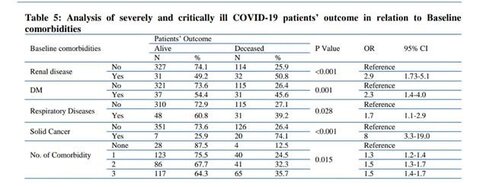The proportion and risk factors of fatal outcomes among severely and critically ill COVID-19 patients: A hospital experience, Baghdad, Iraq
27 Mar 2025
Introduction: In 2003, the World Health Organization (WHO) announced an outbreak of Severe Acute Respiratory Syndrome Coronavirus (SARS COV-1) that caused 8,098 cases of the disease and 774 deaths. In early 2020, Coronavirus disease 2019 (COVID‐19) [Severe Acute Respiratory Syndrome Coronavirus‐2 (SARS CoV‐2)] was announced as a pandemic. Both outbreaks were thought to have started in China (Foshan and Wuhan cities) respectively.
Most ICU reports from the United States have shown that acute respiratory distress syndrome (ARDS) associated with COVID-19 is associated with prolonged periods of mechanical ventilation (MV) and increased mortality.
ARDS is non-cardiogenic pulmonary edema manifested by the rapid development of shortness of breath, tachypnea, and hypoxemia. Diagnostic criteria for ARDS are Onset within one week of a known insult or new or worsening respiratory symptoms, profound hypoxemia, bilateral pulmonary opacity on radiography, and inability to explain respiratory failure due to heart failure or fluid excess.
Objectives: To highlight the risk-factors and its rate for the severe and critical illness among COVID-19 patients, to prevent the disease due to poor data base about this disease at the time of pandemic.
Methods: A descriptive cross-sectional study was conducted on severe and critical cases of COVID-19 patients admitted to the isolation ward in Al-Imam Ali Hospital (which is a general hospital with an RCU unit transformed into an isolation centre for receiving severe and critical cases of COVID-19 only) from 23 March - 23 May 2021. Inclusion criteria: All COVID-19 patients admitted to the hospital as a severe or critical state. Exclusion criteria: Mild or moderate cases who did not need RCU admission and patients still in the hospital. All COVID-19 patients admitted to the hospital as severe or critical cases from 23rd of March to 23rd of May were included in the study, totaling 504 patients. A data collection
form was filled by the researcher through a direct interview to cover the following data: Sociodemographic and clinical features (Age, gender, employment, marital status, education, smoking, alcohol consumption, past medical history, first symptom of COVID-19, anosmia and ageusia, PaO2/FiO2 ratio, ARDS, and the outcome). Lab investigations were done on admission, including CBC, Blood urea, Serum creatinine, D-dimer blood test, Serum ferritin, and lactate dehydrogenase test (LDH). Cases were confirmed by RT-PCR which was performed according to the protocol established by the WHO.
• Severely ill-patients: Percent saturation of oxygen in the blood (SpO2) < 94%, PaO2/FiO2 ratio 30 breaths per minute, and lung infiltration of > 50%.
• Critically ill-patients: Respiratory-failure, septic-shock, or multiple-organ-failure.
Results: A total of 504 severely and critically ill COVID-19 patients were included in this study.
• 71 (14.1%) patients were below 45-year of age, 210 (41.7%) between (45-64) years and 223 (44.2%) 65 years or older.
• Males formed 40.9% of patients while females were 59.1%.
• Fever was the presenting-symptom in 381(75.6%) patients, 197 (39.1%) patients had anosmia.
• There were 358 (71.0%) survivors while 146 (29.0%) died.
• Death risk factors:
- Age: Patients aged 65-year or more had more possible risk for death than those below 65-year.
- Gender: Female gender appeared to be protective compared to male gender.
- Smoking: Ex-smokers had a higher risk than non-smoker and current smokers.
- Renal disease: was found to be a risk-factor leading to death. Diabetes-Mellitus, respiratory diseases, and solid cancer showed a high risk for death. Patients with three comorbidities had a higher mortality risk.
- ARDS: Having mild-ARDS associated with 7.5% Death-ratio. Moderate-ARDS associated with 10.3% death-ratio, while having severe-ARDS was associated with 78.2% death-ratio.
Conclusion: This study concluded that just under a third of severely and critically ill COVID-19 patients may succumb to the disease, with males and older patients having a higher risk of death. Ex-smokers, alcoholics, and patients with baseline comorbidities appeared to be at a higher risk of mortality as well. Laboratory tests and Pao2/Fio2 ratio can be used to predict the outcome, in order to decrease mortality.

Resource information
Respiratory conditions
- COVID-19
Type of resource
Abstract Conference
Brasov 2025